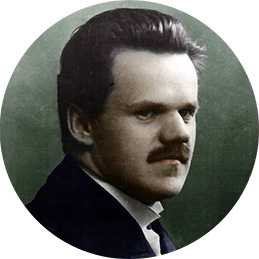Mieczysław Wolfke was born in a May 29, 1883 in Łask near Łódz
He was the son of road engineer, mathematics and physics teacher in middle school in Czestochowa. His mother was sister of Gustaw Kosminski, physicist, student of Mendeleev, Helmholtz and great chemist Fremy. After five years in middle school in Czestochowa, he continued learning in real school in Sosnowiec, where he passed Matura exam. In 1900 he won a patent in Prussia and Russia (which Poland was then a part) on a device, which he called "telektroskop" (telectrosope). This invention was used to send images for some distance via electromagnetic waves. As a young boy he create also surprising rational design of "planetostat" - spaceship based on a recoil principle and he developed mathematical theory of shifts on a surface. For high school education Mieczyslaw Wolfke go to Liege (Belgium), and two years later moved to Sorbona in Paris.
Degree of Doctor of Philosophy (PhD) he obtained with honors in 1910
at University of Wrocław (Prussia in 1910) for dissertation about the abillity of the resolution of optical systems on example of microscope. Despite many great scientific achievements in his later years, its content Mieczysław Wolfke judged the most valueable. It is worth to note that during the stay in Wrocław Mieczysław Wolfke invented a mercury-cadmiom lamp, which invention he sold later to the company Carl-Zeiss Jena, where he worked for a year after obtaining his doctorate. Purely technical career not match Wolfke ambitions, so he took advantage of the proposal to become an assistant in the Faculty of Physics at the technical University of Karlsruhe. In the years 1913-1922 Mieczysław Wolfke stayed with family in Switzerland.
He habilitated at Swiss Federal Institute of Technology in Zurich in a May 26, 1913
(his referees were prof. Albert Einstein i prof. Pierre Weiss), and a year later at University of Zurich. Till the end of his stay in Zurich taught theoretical and experimental physic at both universities. He also worked for the companies Carl-Zeiss and Brown-Boveri, but proposals for stable (well-paid) jobs in the industry he consistently rejected. During his stay in Zurich Mieczysław Wolfke was a member of a small group of physicists who induced the paths of world physics. In this period he publish the paper Über die Möglichkeit der optischen Abbildung von Molekulargittern (About a possibility of optical imaging of molecular gatings) – the world's first concept of holography and the second of the achievements cherished the most by himself.
In 1922, Mieczysław Wolfke moved to the reborn Poland
At Warsaw University of Technology he took over the Department of Physics I, resulting from the division by the university authorities of the Department created and developed by prof. Wiktor Biernacki. An excellent spectroscopic laboratory created by Biernacki have been assigned to Department II. Wolfke could not reconciled with this decision but therefore his interest shifted towards the problems of low temperatures.
In 1924, he started cooperation with Leiden University,
where in low-temperature laboratory of prof. H.K. Kamerlingh-Onnes he investigated the dielectric constant of the liquid helium at various temperatures. This led him to the discovery of two liquid phases of helium and solidification of helium what Mieczysław Wolfke considered as the third of his greatest achievements. In the early thirties Wolfke started to organize the seperated Institute of Low Temperatures at Warsaw University of Technology, even running the first instalation. Unfortunatelly, these plans are interupted by attack of Nazi Germany on Poland in September 1939.
It is worth to note that few years earlier the inventive sense of Wolfke was used by the Ministry of Military Affairs. Wolfke worked for the army on innovative at that times issues, such as optical telephony, night vision or cruise anti-aircraft missiles. As the first Polish scientist predicted the possibility of using nuclear weapons for military purposes.
Mieczyslaw Wolfke was a Freemason of high degree.
In the years 1931-1934 he served as Grand Master of the National Grand Lodge of Poland.
During the Nazi occupation, Mieczyslaw Wolfke directed (with permission of occupier) the Research Department of Theoretical Physics at Warsaw University of Technology, and after liquidation of university he taught at the PWST (State High School of Technology) created in the buildings of Warsaw University of Technology. He organized simultaneously a support for conspiracy and took part in secret teaching. After the outbreak of the Warsaw Uprising 1944 he went to Częstochowa. After liberation of Poland, he taught for a short time at the AGH University of Science and Technology in Krakow, and Gdańsk University of Technology and was involved in the creation of the Silesian University of Technology. In December 1945 he returned to Warsaw, where he proceeded to organize the Department of Physics at the newly relaunched University of Technology. In June 1946 he went to Switzerland for establish contacts and explore current science paths.

